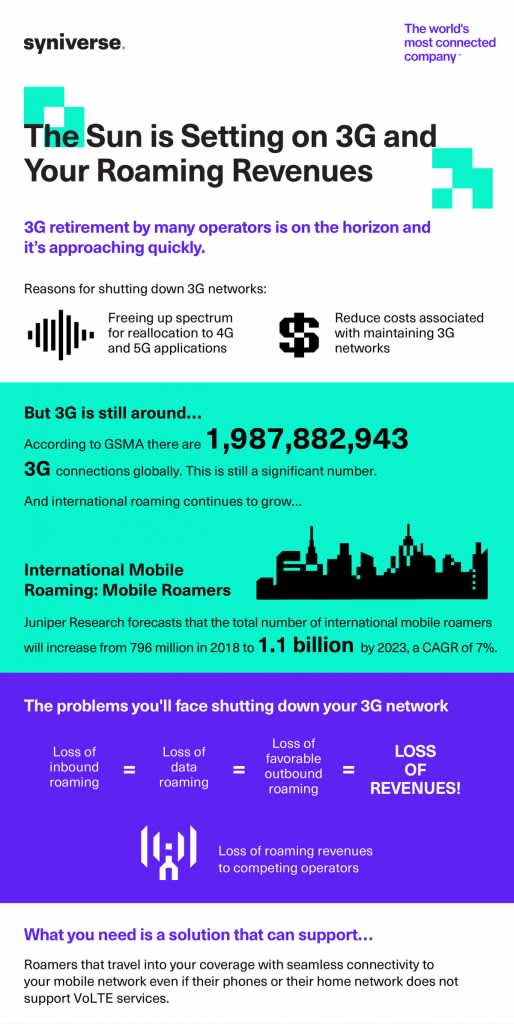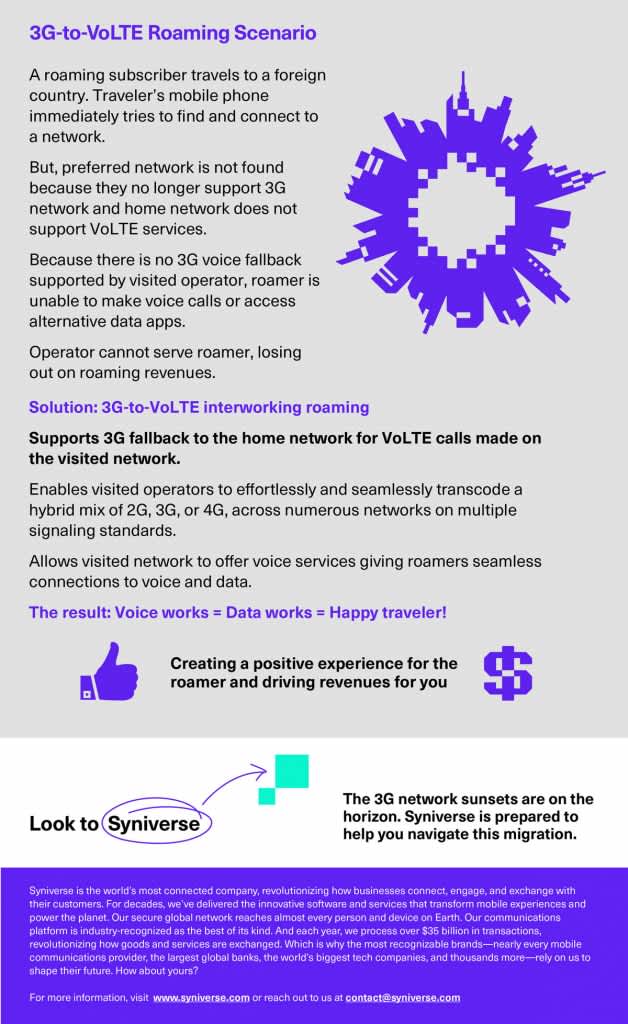It’s no secret that with preparations already in play leading up to the imminent wide-scale implementation of 5G, many mobile network operators are now beginning to shut down older legacy networks, such as 3G, as the industry gets ready to usher in this next evolution of mobile connectivity.
While this shift is undoubtedly exciting, the retirement of 3G networks and their subsequent migration to more advanced iterations has also created significant challenges for servicing a large majority of inbound roamers.
So, where does the industry go from here? Let’s examine these obstacles more closely, along with the proposed solutions that will enable mobile operators to navigate this transition more seamlessly and maintain a positive customer experience in this exciting new era.
Mobile operators are beginning to sunset 3G networks for numerous reasons
Major investments in emerging technologies, combined with the inevitability that aging networks will eventually evolve into bigger and better things, have caused mobile operators to recognize the need to adapt with the times in order to stay relevant and be successful.
While it has proven to be a slow adoption thus far — according to the GSMA, there are still nearly two billion 3G connections operating around the world —shutting down legacy networks, including both 2G and 3G, has proven to be a popular place to start.
The primary drivers incentivizing this changeover are the reductions in costs associated with maintaining these networks, the decrease in the number of resources dedicated to supporting their operability, the ability to accommodate increased 4G bandwidth demands, and perhaps most importantly, the re-allocation of spectrum toward newer technologies like 5G.
While all of these motivating factors to move forward with this sunsetting process certainly are backed by solid reasoning, perhaps what is not so obvious is that this transformation is also driving important considerations within the broader industry, but specifically for mobile operators.

An existing technology has been called to conquer new challenges
As many mobile operators continue to cease operability of their 3G networks, they’re losing their capability to communicate with other operators that don’t have the voice-connecting technology known as Voice over Long-Term Evolution, or VoLTE — a method of routing voice traffic over 4G LTE networks used by mobile operators for transmitting data.
This will have a profound impact for many operators’ roaming business, potentially resulting in a loss of revenue for those that drop 3G support, and even a lack of efficiency and security on the IoT support side of this equation, as some companies continue to utilize older networks — including those dating as far back as 2G to transmit important data across their networks. And while VoLTE technology itself isn’t new, it will prove once again to be a critical component within a larger solution for mitigating these particular circumstances moving forward.
VoLTE first gained prominence for solving how to seamlessly enable voice and data service simultaneously, using an internet technology called Voice over Internet Protocol (VoIP) to transmit both voice and multimedia over internet protocol networks, thereby eliminating the need to have each service delivered separately.
Today, just as they did back then, mobile operators are again looking to provide fluid connectivity — this time for roamers who travel seeking coverage on a visiting network, even in cases where their mobile devices or home networks do not support VoLTE services.
Real-life scenarios warrant a real-time solution — and Syniverse can help
Oftentimes when roaming subscribers travel to foreign countries, their mobile devices immediately try to locate and establish network connections upon entering that country’s coverage area. In some cases, however, a visited network cannot be found because it no longer supports 3G, and thus, can’t support voice services beyond VoLTE over their existing, more advanced 4G network.
Similarly, if a roaming subscriber connects to a visited network that also no longer supports 3G, the subscriber then must have a VoLTE-enabled device, and their home network must also support VoLTE, in order for them to make a voice call and subsequently use data over that device while roaming. If their home network, however, does not support this capability, they will not be able to do either.
In cases where visited operators don’t support 3G fallback, roaming subscribers without VoLTE-enabled mobile devices are typically at a major disadvantage, as are the visited operators themselves, which cannot offer service to the roaming subscriber, thus losing out on revenue.
This downside, of course, comes much to the dismay of visited operators when roaming subscribers’ devices find alternative operators that do, in fact, support 3G, and which can deliver both voice and data services across the same network. This competing operator now becomes the serving network and receives the affiliated roaming revenue, causing the preferred operator to lament a missed opportunity.
Service providers, however, have the ability to favorably deliver mobile connectivity to travelers, while maintaining a positive customer experience and keeping the network providers’ roaming revenues where they should be, thanks to Evolved Mobility, Syniverse’s 3G-to-VoLTE roaming interworking solution.
This innovative approach allows 4G- and 5G-only operators to support 3G fallback to the home network for VoLTE calls made on the visited network, which for the first time, would enable subscribers to effortlessly utilize voice and data services that otherwise would have been unavailable.
Furthermore, it enables visited operators to seamlessly accept 4G connections across numerous networks and is intended to give non-VoLTE network operators a way to roam without either side having to make major equipment upgrades. Now preferred networks can offer voice and data services without the use of VoLTE, giving roamers seamless connections to both voice and data, resulting in a mutually beneficial outcome for both roaming subscribers and mobile network operators.
As the VoLTE technology continues to improve all facets of roaming for both parties alike, each will come to adopt a keen interest in gaining access to these same immersive, user-first experiences as the new standard moving forward. The power, therefore, lies in the hands of those who are bold enough to embrace this change.





